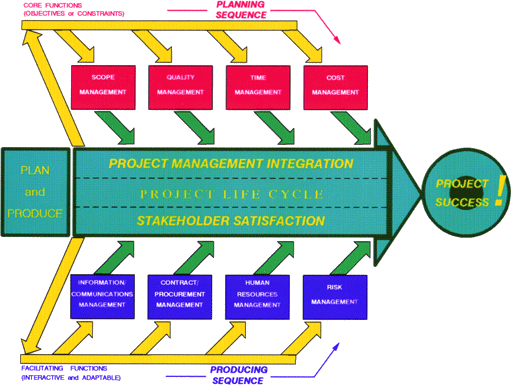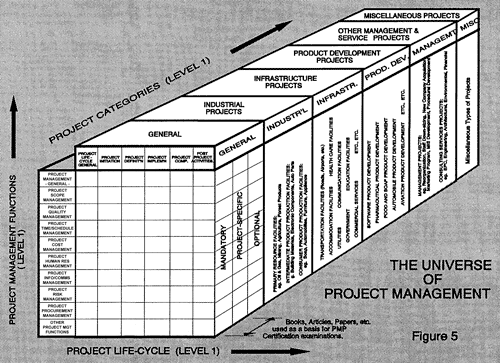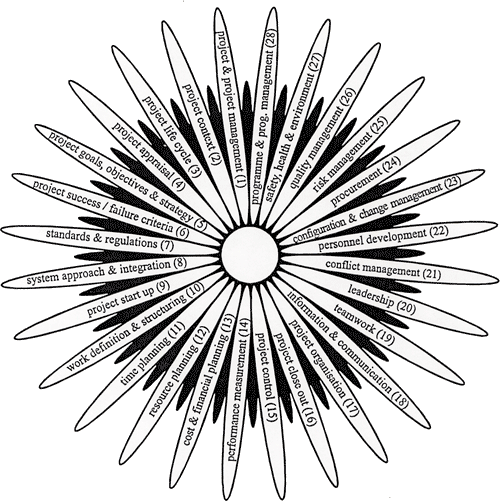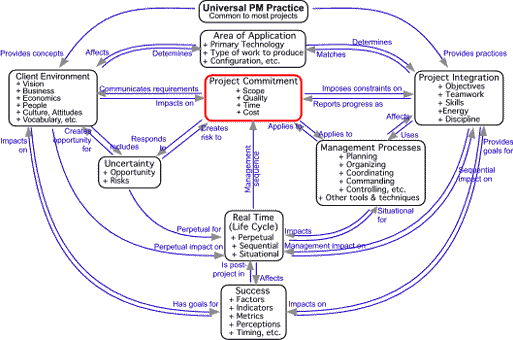Project Management Models in the Nineties
In the early nineties, a number of senior project management practitioners felt that the discussion of a project management model was becoming too academic and that a more practical illustration was required with a particular focus on the target, stakeholder satisfaction and success. Several iterations resulted in the "Arrow" diagram as shown in Figure 10.[21] The illustration encompasses all of the topics previously identified, segregates "core" functions from "facilitating" functions, i.e. the "hard" and "soft" sides of project management, and emphasizes the cyclical nature of management throughout the project life span.

In late 1991, Warren Allen postulated a more comprehensive three dimensional
model of project management knowledge in a paper titled "The Universe
of Project Management: A Comprehensive Project Management Classification Structure
(PCMS) to Update and Expand the Dimensions of PMI's PMBOK". The paper
arose out of a discussion amongst a group of interested PMI members prior to
the annual seminar/symposium. Allen's model related the nine or more "Level
1" project management functions with the generic project life cycle and
with the potential for considerably extended knowledge in various industry
applications. Allen sees the objective as starting "to provide a rational
basis for classifying all of the project management information that is a part
of our evolving body of knowledge."
The paper provides a good summary of the requirements for such
a model and a detailed description of its various elements. It shows how
the generic body of PM knowledge is only a small fraction of the total body
of knowledge. Unfortunately, the Project Management Institute subsequently
declined the paper for publication, failing to see its prophetic nature, and
it appears that the author lost interest. The model is shown in Figure
10a.[21a]

Meantime, much thought amongst members of the International Project Management
Association ("IPMA") in Europe was being given to the content of project management.
However, great difficulty was encountered in trying to reach any sort of agreement
on relationship structure. As a compromise, the "Sun Wheel" was published around
1996 consisting of 28 subject areas as shown in Figure 11.

Figure 11: The IPMA's sun wheel
Another serious attempt was made by this author in a presentation at the Project Management Institute's 1997 annual seminar/symposium. The paper was entitled "A Project Management Knowledge Structure for the Next Century" and so addressed not how to do project management, the subject of most papers, but what such a "knowledge structure" should look like, and the need and value of an acceptable model. The work was based on the idea of "concept mapping" and drew heavily on work by previous authors over the years.
The paper discussed how to set about such a concept map, the right perspective, the objectives, assumptions necessary, what to include or not, and relevant definitions of terms. However, at the core of the concept map is the idea of a "Project Commitment", between a project manager and his/her team and a client/sponsor, to produce some agreed product within prescribed constraints. The resulting concept map is shown in Figure 12, complete with object relationships and attributed. The full paper can be seen at http://www.maxwideman.com/papers/knowledge/intro.htm.

Figure 12: Wideman's concept map of project management
The 1997 paper was followed the following year with another paper in which more detail was suggested together with a concomitant work breakdown structure, a technique more familiar to most project management practitioners. The 1998 paper titled "Defining Project Management Knowledge as a Basis for Global Communication, Learning and Professionalism" can be seen at http://www.maxwideman.com/papers/global/intro.htm.
21. Thanks to Brian Fletcher, Eric Jenett, Chris Quaife, et al, circa 1991.
21a. Allen, W.E., P.Eng., CMC, PMP, Panalta Management Associates Inc., Calgary, Alberta, 1991.
|



